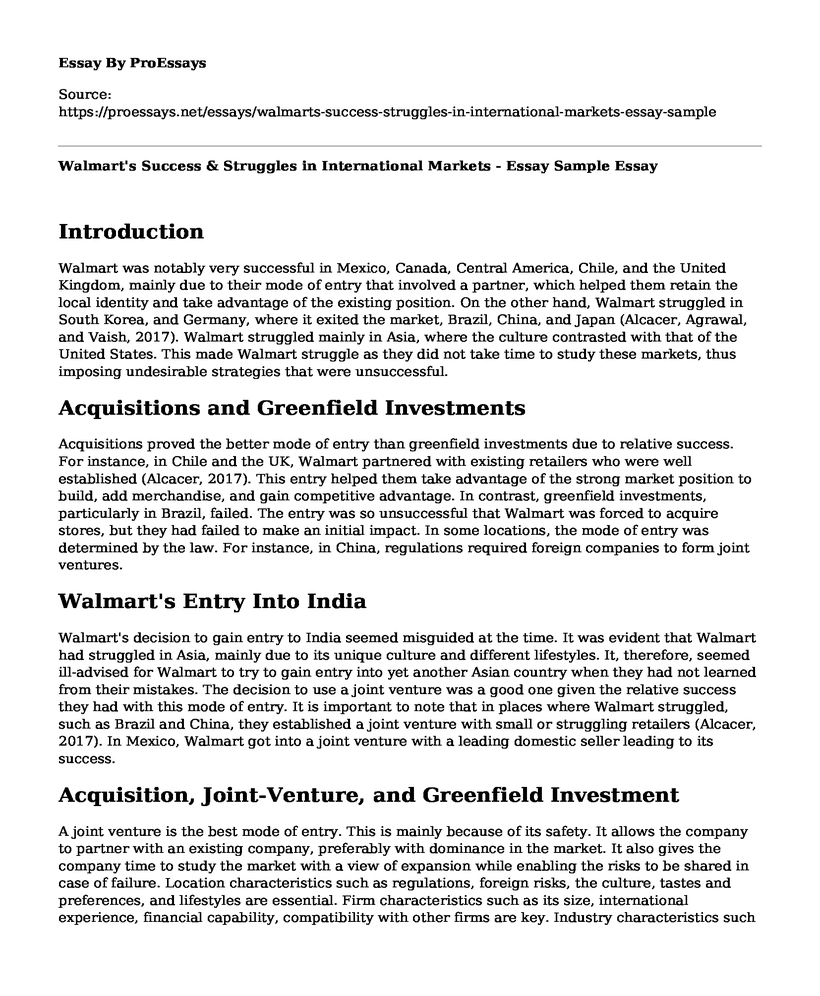Introduction
Walmart was notably very successful in Mexico, Canada, Central America, Chile, and the United Kingdom, mainly due to their mode of entry that involved a partner, which helped them retain the local identity and take advantage of the existing position. On the other hand, Walmart struggled in South Korea, and Germany, where it exited the market, Brazil, China, and Japan (Alcacer, Agrawal, and Vaish, 2017). Walmart struggled mainly in Asia, where the culture contrasted with that of the United States. This made Walmart struggle as they did not take time to study these markets, thus imposing undesirable strategies that were unsuccessful.
Acquisitions and Greenfield Investments
Acquisitions proved the better mode of entry than greenfield investments due to relative success. For instance, in Chile and the UK, Walmart partnered with existing retailers who were well established (Alcacer, 2017). This entry helped them take advantage of the strong market position to build, add merchandise, and gain competitive advantage. In contrast, greenfield investments, particularly in Brazil, failed. The entry was so unsuccessful that Walmart was forced to acquire stores, but they had failed to make an initial impact. In some locations, the mode of entry was determined by the law. For instance, in China, regulations required foreign companies to form joint ventures.
Walmart's Entry Into India
Walmart's decision to gain entry to India seemed misguided at the time. It was evident that Walmart had struggled in Asia, mainly due to its unique culture and different lifestyles. It, therefore, seemed ill-advised for Walmart to try to gain entry into yet another Asian country when they had not learned from their mistakes. The decision to use a joint venture was a good one given the relative success they had with this mode of entry. It is important to note that in places where Walmart struggled, such as Brazil and China, they established a joint venture with small or struggling retailers (Alcacer, 2017). In Mexico, Walmart got into a joint venture with a leading domestic seller leading to its success.
Acquisition, Joint-Venture, and Greenfield Investment
A joint venture is the best mode of entry. This is mainly because of its safety. It allows the company to partner with an existing company, preferably with dominance in the market. It also gives the company time to study the market with a view of expansion while enabling the risks to be shared in case of failure. Location characteristics such as regulations, foreign risks, the culture, tastes and preferences, and lifestyles are essential. Firm characteristics such as its size, international experience, financial capability, compatibility with other firms are key. Industry characteristics such as level of competition, customer loyalty, availability of resources, and suppliers also have to be considered.
Reference
Alcacer, J., Agrawal, A., and Vaish, H. (2017, Jan. 3). Walmart Around the World. Harvard Business School.
Cite this page
Walmart's Success & Struggles in International Markets - Essay Sample. (2023, May 14). Retrieved from https://proessays.net/essays/walmarts-success-struggles-in-international-markets-essay-sample
If you are the original author of this essay and no longer wish to have it published on the ProEssays website, please click below to request its removal:
- Unilateral Rights and Exceptional Circumstances: Asda vs. Bateman Case Study
- Smith Industries Global Expansion Opportunities Paper Example
- Essay Sample on Target's Stakeholder Relationships
- Creating Safe & Conducive Working Environments: A Must-Do For Organizations - Essay Sample
- Paper Example on Constructing Trust: Investigating the Role of Social Support in C2C Social Commerce
- Essay on Uber's Global Expansion: The Result of Savvy Marketing and Modern Payment Methods
- Market Research on Hulu - Report Example







